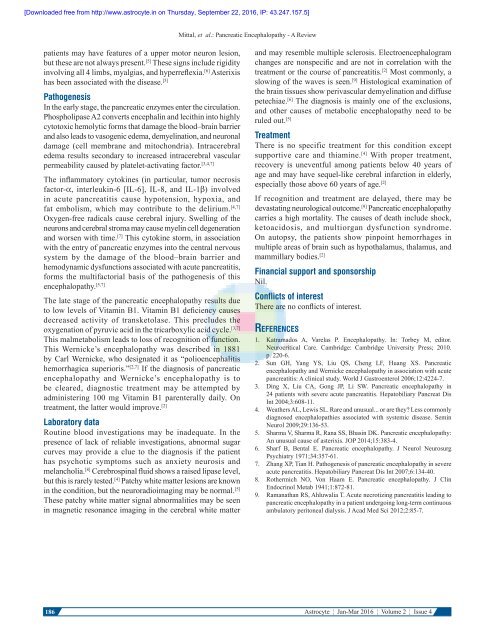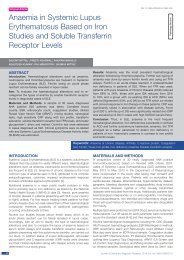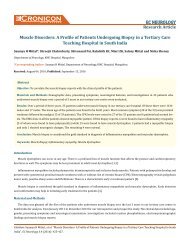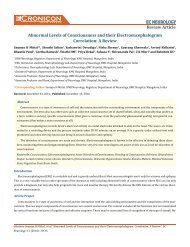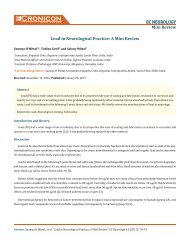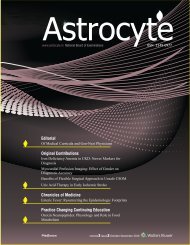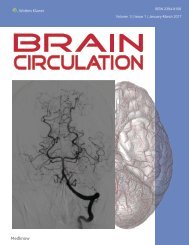The Uncommon Syndrome of Pancreatic Encephalopathy
Create successful ePaper yourself
Turn your PDF publications into a flip-book with our unique Google optimized e-Paper software.
[Downloaded free from http://www.astrocyte.in on Thursday, September 22, 2016, IP: 43.247.157.5]<br />
Mittal, et al.: <strong>Pancreatic</strong> <strong>Encephalopathy</strong> - A Review<br />
patients may have features <strong>of</strong> a upper motor neuron lesion,<br />
but these are not always present. [5] <strong>The</strong>se signs include rigidity<br />
involving all 4 limbs, myalgias, and hyperreflexia. [6] Asterixis<br />
has been associated with the disease. [5]<br />
Pathogenesis<br />
In the early stage, the pancreatic enzymes enter the circulation.<br />
Phospholipase A2 converts encephalin and lecithin into highly<br />
cytotoxic hemolytic forms that damage the blood–brain barrier<br />
and also leads to vasogenic edema, demyelination, and neuronal<br />
damage (cell membrane and mitochondria). Intracerebral<br />
edema results secondary to increased intracerebral vascular<br />
permeability caused by platelet‐activating factor. [3,4,7]<br />
<strong>The</strong> inflammatory cytokines (in particular, tumor necrosis<br />
factor‐α, interleukin‐6 [IL‐6], IL‐8, and IL‐1β) involved<br />
in acute pancreatitis cause hypotension, hypoxia, and<br />
fat embolism, which may contribute to the delirium. [4,7]<br />
Oxygen‐free radicals cause cerebral injury. Swelling <strong>of</strong> the<br />
neurons and cerebral stroma may cause myelin cell degeneration<br />
and worsen with time. [7] This cytokine storm, in association<br />
with the entry <strong>of</strong> pancreatic enzymes into the central nervous<br />
system by the damage <strong>of</strong> the blood–brain barrier and<br />
hemodynamic dysfunctions associated with acute pancreatitis,<br />
forms the multifactorial basis <strong>of</strong> the pathogenesis <strong>of</strong> this<br />
encephalopathy. [5,7]<br />
<strong>The</strong> late stage <strong>of</strong> the pancreatic encephalopathy results due<br />
to low levels <strong>of</strong> Vitamin B1. Vitamin B1 deficiency causes<br />
decreased activity <strong>of</strong> transketolase. This precludes the<br />
oxygenation <strong>of</strong> pyruvic acid in the tricarboxylic acid cycle. [3,7]<br />
This malmetabolism leads to loss <strong>of</strong> recognition <strong>of</strong> function.<br />
This Wernicke’s encephalopathy was described in 1881<br />
by Carl Wernicke, who designated it as “polioencephalitis<br />
hemorrhagica superioris.” [2,7] If the diagnosis <strong>of</strong> pancreatic<br />
encephalopathy and Wernicke’s encephalopathy is to<br />
be cleared, diagnostic treatment may be attempted by<br />
administering 100 mg Vitamin B1 parenterally daily. On<br />
treatment, the latter would improve. [2]<br />
Laboratory data<br />
Routine blood investigations may be inadequate. In the<br />
presence <strong>of</strong> lack <strong>of</strong> reliable investigations, abnormal sugar<br />
curves may provide a clue to the diagnosis if the patient<br />
has psychotic symptoms such as anxiety neurosis and<br />
melancholia. [8] Cerebrospinal fluid shows a raised lipase level,<br />
but this is rarely tested. [4] Patchy white matter lesions are known<br />
in the condition, but the neuroradioimaging may be normal. [5]<br />
<strong>The</strong>se patchy white matter signal abnormalities may be seen<br />
in magnetic resonance imaging in the cerebral white matter<br />
and may resemble multiple sclerosis. Electroencephalogram<br />
changes are nonspecific and are not in correlation with the<br />
treatment or the course <strong>of</strong> pancreatitis. [2] Most commonly, a<br />
slowing <strong>of</strong> the waves is seen. [9] Histological examination <strong>of</strong><br />
the brain tissues show perivascular demyelination and diffuse<br />
petechiae. [6] <strong>The</strong> diagnosis is mainly one <strong>of</strong> the exclusions,<br />
and other causes <strong>of</strong> metabolic encephalopathy need to be<br />
ruled out. [5]<br />
Treatment<br />
<strong>The</strong>re is no specific treatment for this condition except<br />
supportive care and thiamine. [4] With proper treatment,<br />
recovery is uneventful among patients below 40 years <strong>of</strong><br />
age and may have sequel‐like cerebral infarction in elderly,<br />
especially those above 60 years <strong>of</strong> age. [2]<br />
If recognition and treatment are delayed, there may be<br />
devastating neurological outcome. [9] <strong>Pancreatic</strong> encephalopathy<br />
carries a high mortality. <strong>The</strong> causes <strong>of</strong> death include shock,<br />
ketoacidosis, and multiorgan dysfunction syndrome.<br />
On autopsy, the patients show pinpoint hemorrhages in<br />
multiple areas <strong>of</strong> brain such as hypothalamus, thalamus, and<br />
mammillary bodies. [2]<br />
Financial support and sponsorship<br />
Nil.<br />
Conflicts <strong>of</strong> interest<br />
<strong>The</strong>re are no conflicts <strong>of</strong> interest.<br />
References<br />
1. Katramados A, Varelas P. <strong>Encephalopathy</strong>. In: Torbey M, editor.<br />
Neurocritical Care. Cambridge: Cambridge University Press; 2010.<br />
p. 220‐6.<br />
2. Sun GH, Yang YS, Liu QS, Cheng LF, Huang XS. <strong>Pancreatic</strong><br />
encephalopathy and Wernicke encephalopathy in association with acute<br />
pancreatitis: A clinical study. World J Gastroenterol 2006;12:4224‐7.<br />
3. Ding X, Liu CA, Gong JP, Li SW. <strong>Pancreatic</strong> encephalopathy in<br />
24 patients with severe acute pancreatitis. Hepatobiliary Pancreat Dis<br />
Int 2004;3:608‐11.<br />
4. Weathers AL, Lewis SL. Rare and unusual... or are they? Less commonly<br />
diagnosed encephalopathies associated with systemic disease. Semin<br />
Neurol 2009;29:136‐53.<br />
5. Sharma V, Sharma R, Rana SS, Bhasin DK. <strong>Pancreatic</strong> encephalopathy:<br />
An unusual cause <strong>of</strong> asterixis. JOP 2014;15:383‐4.<br />
6. Sharf B, Bental E. <strong>Pancreatic</strong> encephalopathy. J Neurol Neurosurg<br />
Psychiatry 1971;34:357‐61.<br />
7. Zhang XP, Tian H. Pathogenesis <strong>of</strong> pancreatic encephalopathy in severe<br />
acute pancreatitis. Hepatobiliary Pancreat Dis Int 2007;6:134‐40.<br />
8. Rothermich NO, Von Haam E. <strong>Pancreatic</strong> encephalopathy. J Clin<br />
Endocrinol Metab 1941;1:872‐81.<br />
9. Ramanathan RS, Ahluwalia T. Acute necrotizing pancreatitis leading to<br />
pancreatic encephalopathy in a patient undergoing long‐term continuous<br />
ambulatory peritoneal dialysis. J Acad Med Sci 2012;2:85‐7.<br />
186<br />
Astrocyte ¦ Jan-Mar 2016 ¦ Volume 2 ¦ Issue 4


